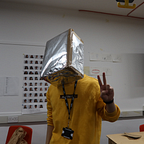22/04/21–10/06/21 (7 weeks)
📃Brief: Design a way to materialise the blockchain.
🤝Group Members: Alex Newson, Tatiana Bohsali, Sue Heeyeon An, Yiwei Han (David).
👁🗨External Partner: This Ain’t Rock’n’Roll — Charlie Waterhouse, Clive Russell
What we need to do?
Based on the feedback, I have revisited the first five weeks of the design process and created a framework and plan for our design process using the OSI Model as a reference. The first two weeks were spent learning about the underlying infrastructure such as cryptography, and the features of the blockchain level. In the third and fourth weeks, we learnt about the application level of the blockchain. In week five, we came to the presentation layer and designed the app interface.
But unfortunately these interfaces did not at all show or illustrate any of the invisible blockchain features and applications that we had learned in the first four weeks. For example, the transparency and openness of blockchain information, immutability, automatic execution of Smart Contract, autonomy of DAO, etc. So one task for this week was to select some materialiseable blockchain elements that applied to our idea and to come up with a way to communicate and externalise it.
Workshop
On the other hand, in order to continue with the “democratic” and “decentralised” nature of our idea, we decided to invite Brixton residents to a workshop to discuss the first generation of Brixspot proposals. Unfortunately, we didn’t have much time to plan it, so we ended up using fellow students instead. We decided that since they weren’t Brixton residents, we would let them envision a mobile autonomous shop and its rules for LCC that would meet the needs of students based on blockchain technology.
Alex created the PPT and the flow of the whole workshop and I was responsible for videoing and recording the process. Participants came up with the idea of a snack and sweet mobile shop, as well as rules for sweet-for-sweet and move-on-demand. This idea would be put into practice in our next prototype.
Prototyping
In terms of materialising the blockchain, I came up with the idea of informing people of their actions in relation to the blockchain through the flashing of LED lights with different colour. Alex came up with the idea of materialising the features of the blockchain open ledger by having people write down a record of their transactions. I later thought perhaps this approach could be enhanced and reduce the number of steps for the user through automatic printing. Tatiana came up with the idea of embodying the blockchain verification mechanism by using “the word of mouth”. Sue designed the logo for our whole idea: Brixtonspot and the colour pattern.
We then made and prepared the introduction and rules of Brixspot XYZ (all from workshop), the interactive equipment (ipad), the LED lights part, and the component for writing records and materials of making this store (tatiana’s cabinet & mount paper).
Speed Dating
In this round of feedback, testers were overwhelmed by the overwhelming amount of information, and they didn’t know which part to look at first. The de-technology of the traditional digital lock also caused a lot of inconvenience. Nonetheless, they gave us a lot of advice, and we were inspired by Zhaolu’s suggestion that we use the camera to capture hand movements and generate photos automatically.
Our tasks for next week are: to clarify the purpose of the final store; to make the entire flow of information and interaction clear and understandable; and to improve the quality of the final prototype.
Reflection
Our design process has more than once confirmed Ingold’s view of design and making, a tension between the pull of the imagination and the drag of material constraints. At the prototyping stage, for example, we were always limited to thinking about how to make the shapes/looks based on the materials we had on hand or could buy in the given time. Although we have many interesting and creative possibilities, we choose to discard them because we do not know what materials and techniques to use to achieve them. We are not only constrained by the material itself, but also by our knowledge and insight of the material, our knowledge and insight of the technique and so on.
As designers, we should strive to broaden our horizons, both in terms of materials and technology, and try to push the limits of materials again and again to pursue and meet places of imagination and hope.
“It is precisely where the reach of the imagination meets the friction of materials, or where the forces of ambition rub up against the rough edges of the world, that human life is lived.” — Tim Ingold.
📚References
Ingold, T. (2013), Making: Anthropology, Archaeology, Art and Architecture. Routledge London.
